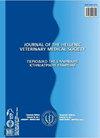First report of detection of Canine Parvovirus type 2 in naturally infected domestic cats in Egypt by duplex PCR for simultaneous detection of Canine Parvovirus type 2 and Feline Panleukopenia virus
IF 0.4
4区 农林科学
Q4 VETERINARY SCIENCES
引用次数: 0
Abstract
Feline Panleukopenia virus (FPLV) and Canine Parvovirus type 2 (CPV) cause fatal gastroenteritis in cats and dogs. In this study we developed a duplex polymerase chain reaction (dPCR) assay for the concurrent detection of FPLV and CPV-2 in a single PCR tube. Two primers were used based on nucleic acid conserved regions of the two viruses which specifically amplify 237 bp of the VP2 gene of FPLV and 583 bp of the VP2 gene of CPV 2.Sensitivity and Specificity of the dPCR were evaluated. A total of 30 rectal/fecal swabs were collected from domestic cats in Kafrelsheikh province, Egypt and were tested for FPLV and CPV-2 viruses using the dPCR assay. The results revealed that this dPCR assay was sensitive, as it could detect a minimum of 1 × 105 copies of genomic DNA of the two viruses. The dPCR assay was highly specific as there was no amplification of nucleic acid of other feline and canine pathogens. The positive ratio was 83.3% (25/30) for FPLV and 16.6% (5/30) for CPV respectively. Further analyses of CPV samples by Restriction Fragment Length Polymorphism (RFLP) revealed that they are classified as CPV 2a/2b variants. This study reports the first detection of CPV 2a/2b from symptomatic cats in Egypt using dPCR assay that can detect FPLV and CPV in a single tube reaction.用双链聚合酶链反应同时检测2型犬细小病毒和猫泛白细胞减少症病毒,在埃及首次报道在自然感染的家猫中检测到2型犬细小病毒
猫泛白细胞减少病毒(FPLV)和犬细小病毒2型(CPV)引起猫和狗的致命胃肠炎。在这项研究中,我们建立了一种双聚合酶链反应(dPCR)方法,用于在单个PCR管中同时检测FPLV和CPV-2。根据两种病毒的核酸保守区,采用两种引物特异性扩增FPLV的VP2基因237 bp和cpv2的VP2基因583 bp。评价dPCR的敏感性和特异性。从埃及Kafrelsheikh省的家猫身上共收集了30份直肠/粪便拭子,并使用dPCR法检测了FPLV和CPV-2病毒。结果表明,该方法灵敏度高,可检测到两种病毒基因组DNA的至少1 × 105个拷贝。dPCR检测具有很高的特异性,因为没有扩增其他猫和犬病原体的核酸。FPLV阳性率为83.3% (25/30),CPV阳性率为16.6%(5/30)。通过限制性片段长度多态性(RFLP)对CPV样本进行进一步分析,发现它们属于CPV 2a/2b变体。本研究报道了首次在埃及有症状的猫中使用dPCR检测CPV 2a/2b,该方法可以在单管反应中检测到FPLV和CPV。
本文章由计算机程序翻译,如有差异,请以英文原文为准。
求助全文
约1分钟内获得全文
求助全文
来源期刊

Journal of the Hellenic Veterinary Medical Society
VETERINARY SCIENCES-
CiteScore
0.60
自引率
0.00%
发文量
83
审稿时长
>12 weeks
期刊介绍:
The Journal of the Hellenic Veterinary Medical Society (J Hellenic Vet Med Soc) is a quarterly peer-reviewed journal that publishes articles in all aspects of veterinary science and related disciplines. It is published by the Hellenic Veterinary Medical Society and is indexed in the Web of Science and in Scopus.
There are no publication fees in the journal. Authors considering submitting manuscripts for evaluation and publication are requested to read carefully the instructions for authors and fully comply with them.
Non-complying manuscripts may be returned to the corresponding author for formatting.
 求助内容:
求助内容: 应助结果提醒方式:
应助结果提醒方式:


